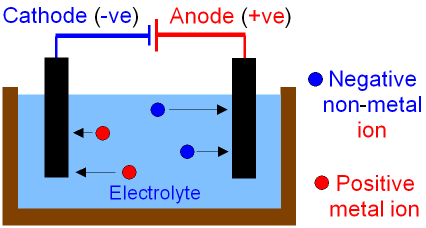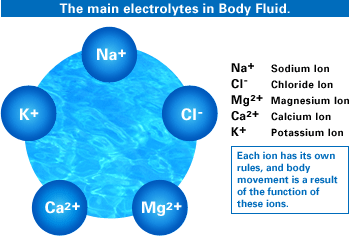Sir Humphrey Davy used electrolysis to decompose compounds which most chemists had thought were elements in 1807. Davy's work led to the discovery of many reaction metals in Group1 and 2 of the periodic table, including potassium, sodium, calcium and magnesium. We still use electrolysis to make reactive metals, as well as some everyday metals such as aluminium.
WHAT IS ELECTROLYSIS?
electrolysis is the splitting up of a substance by electricity, in chemistry we use words which end in lysis to describe reactions in which something is being decomposed or split up. Many of the terms we use to describe electrolysis were introduced in the 1830s by Faraday, who began his scientific career as an assistant to Davy. Much of our present understanding of electrolysis is based on the work which Faraday did during his time here on earth.
IMPORTANT WORDS IN ELECTROLYSIS
Electrolyte...... A substance which conducts electricity only when it melts or dissolves in water.
Electrode........ A metal or graphite rod which allows electrons to enter or leave an electrolyte.
Cathode........... The negative electrode - electrons move towards it.
Anode.......... The positive electrode - electrons flow away from it.
Battery....... A source of DC (direct current) electricity - this pushes electrons around the circuit.
ELECTROLYTE
An electrolyte contains ions. When the electrolyte melts or dissolves in water, the ions become free to move. During electrolysis, the positively charged ions move to the cathode. This is the reason why the positive ions are sometimes called cations. In the same way the negative ions move to the positively charged anode and they are also called anions.
THE REASON BEHIND MELTING ELECTROLYTES
Most reactive metals are made by melting and then electrolysing their compounds. Aluminium is produced on a very large scale in this way. Reactive metals are costly to produce. The compounds in which these metals are found have very high melting points and a lot of energy is needed to melt them. A flow of electricity through an electrolyte is only possible if the ions are free to move. When the electrolyte is a solid, the positive charged ions attract each other strongly and are not free to move about. This is why electrolytes are insulators in their solid state. Heating the electrolyte breaks down the attraction between the ions. Each ion then moves to the electrode which is oppositely charge. This ionic movement produces a flow of electricity and the electrolyte becomes a conductor.
WHY DO DISSOLVED SUBSTANCES CONDUCT ELECTRICITY?
The ions in a soluble electrolyte can be separated by adding water. Molecules of water breakdown the attraction between oppositely charged ions. This allows the ions to move between the electrodes in an electrolysis circuit and the electrolyte becomes a conductor.
Source
USING ELECTROLYTE SOLUTION FOR PLATING
Chromium is an attractive metal which is often used to produce a decorative finish on the trim of cars or bicycles. It can be electroplated on to other metals by an electrolysis circuit. Using a dissolved chromium compound as the electrolyte will produce a covering of chromium on the cathode. If we replace the chromium electrolyte by one in which gold is present, we can produce a gold finish on the cathode. The anode dissolves as current flows through it. The ions which go into solution at the anode replace those which are used up by the cathode reaction and this means the anode must always be made of the same metal as the one dissolved in the electrolyte.
USING ELECTROLYSIS IN PURIFYING COPPER
Copper is usually found in the earth's crust as an ores containing as little as 0.4% of copper. Most copper ores are either sulphides or oxides. They contain no more than about two percent of the metal. Impurities reduce the ability of actualising metal to conduct the electricity. Copper needs to be more than 99.9% pure before we can use it as an electrical conductor. To make copper as pure as this we use an electrolytic method of refining the metal. The number of copper ions in the electrolyte does not change during the electrolysis. This is because copper ions go into solution at the anode at the same rate as they leave the electrolyte at the cathode. As copper is plated on to it the purity of the cathode increases to more than 99.9%. The anodes are replaced from time to time as they are gradually used up by the electrode reaction.
ELECTROLYSIS IN FOOD PRESERVATION
electrolysis plays a big part in food preservation. Almost all the food cans in the supermarket are made from an electroplated metal called tinplate. This is made from steel, rolled to a thickness of no more than 0.1mm. To protect it from corrosion, it is covered on both sides with even thinner layers of tin. About half of the drinks cans we use are made from tinplate. The rest are made from aluminium another metal made using electrolysis.
ELECTROLYSIS IN CAR PRODUCTION
car manufacturers use electrolysis to apply a zinc coating to car bodies. The electrolyte in which the car body is being dipped contains a zinc compound. The car body is the cathode increases an electrolysis circuit. This process covers the steel shell of the car with a layer of zinc metal which stops the car rusting
CONCLUSION
We have to melt electrolytes or dissolve them in water to make them conduct electricity. They are insulators when solid. Ions are discharged at the electrodes when electrolysis takes place. This leads to decomposition of the electrolyte into its elements. We usually get hydrogen gas or a metal as the electrolysis product at the cathode.
REFERENCES



I’m not a scientist nor a science student but I can sense your hardwork in this post, thanks for such explanation, you’ll make a good science teacher!
Downvoting a post can decrease pending rewards and make it less visible. Common reasons:
Submit
Thanks for your nice compliment
Downvoting a post can decrease pending rewards and make it less visible. Common reasons:
Submit
Congratulations @chidiebere! You have completed some achievement on Steemit and have been rewarded with new badge(s) :
Click on any badge to view your own Board of Honor on SteemitBoard.
For more information about SteemitBoard, click here
If you no longer want to receive notifications, reply to this comment with the word
STOPDownvoting a post can decrease pending rewards and make it less visible. Common reasons:
Submit